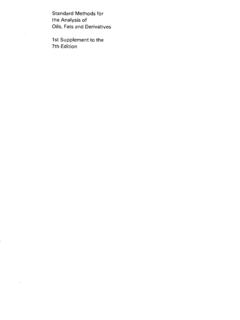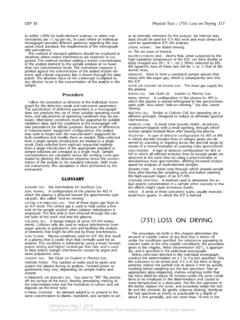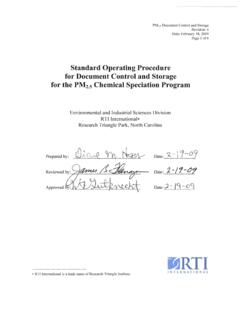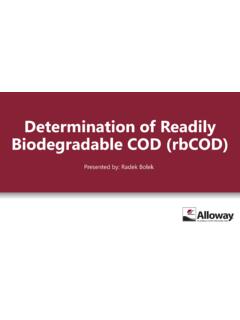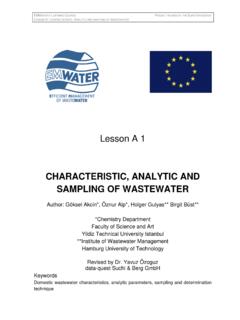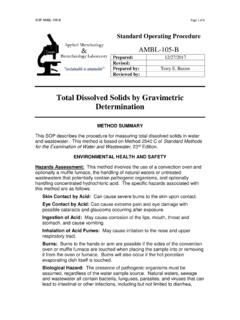Transcription of METHOD 5021A VOLATILE ORGANIC COMPOUNDS IN …
1 SW 846 Update V 5021A 1 Revision 2 July 2014 METHOD 5021A VOLATILE ORGANIC COMPOUNDS IN VARIOUS SAMPLE MATRICES USING EQUILIBRIUM HEADSPACE ANALYSIS SW 846 is not intended to be an analytical training manual. Therefore, METHOD procedures are written based on the assumption that they will be performed by analysts who are formally trained in at least the basic principles of chemical analysis and in the use of the subject technology. In addition, SW 846 methods, with the exception of required METHOD use for the analysis of METHOD defined parameters, are intended to be guidance methods which contain general information on how to perform an analytical procedure or technique which a laboratory can use as a basic starting point for generating its own detailed standard operating procedure (SOP), either for its own general use or for a specific project application.
2 The performance data included in this METHOD are for guidance purposes only, and are not intended to be and must not be used as absolute QC acceptance criteria or for the purpose of laboratory accreditation. SCOPE AND APPLICATION Please see Appendix A at the end of this document for a summary of changes from the previous version. This METHOD describes equilibrium based static headspace preparation of VOLATILE ORGANIC COMPOUNDS (VOCs) in soil/sediment, solid waste, aqueous and water miscible liquid samples for determination by gas chromatography (GC) or gas chromatography/mass spectrometry (GC/MS).
3 This METHOD is applicable to a wide range of ORGANIC COMPOUNDS that have sufficiently high volatility to be effectively removed from samples using the described conditions. While the METHOD is designed for use on samples containing low levels of VOCs or aqueous dilutions thereof to be analyzed by direct vapor partitioning, a solvent extraction and extract introduction procedure is also described for solid samples containing high concentrations of VOCs or for oily materials that may not be appropriate for the low level technique. This preparation METHOD is intended to be combined with a determinative METHOD such as Methods 8015, 8021 or 8260.
4 This preparation METHOD is appropriate for the COMPOUNDS listed below, and it may also be appropriate for other VOCs included in the determinative METHOD ( , Sec. of 8260), provided METHOD performance is demonstrated to be acceptable for the intended use of the data. Compound CAS Response Stability Acetone 67 64 1 ws hs t Amyl alcohol (TAA) 75 85 4 nd hs t Amyl ethyl ether (TAEE) 919 94 8 nd nd t Amyl methyl ether (TAME) 994 05 8 nd hs Benzene 71 43 2 c hs Bromochloromethane 74 97 5 p hs Bromodichloromethane 75 27 4 c ms Bromoform 75 25 2 p hs Bromomethane 74 83 9 c hvs SW 846 Update V 5021A 2 Revision 2 July 2014 Compound CAS Response Stability t Butyl alcohol (TBA)
5 75 65 0 ws nd Carbon tetrachloride 56 23 5 c hvs Chlorobenzene 108 90 7 c hvs Chloroethane 75 00 3 c c ms Chloroform 67 66 3 c hs Chloromethane 74 87 3 c hvs Dibromochloromethane 124 48 1 p nd 1,2 Dibromo 3 chloropropane 96 12 8 p ms 1,2 Dibromoethane 106 93 4 p hs Dibromomethane 74 95 3 p hs 1,2 Dichlorobenzene 95 50 1 c hs 1,3 Dichlorobenzene 541 73 1 c ms 1,4 Dichlorobenzene 106 46 7 c ms Dichlorodifluoromethane 75 71 8 c hs 1,1 Dichloroethane 75 34 3 c hs 1,2 Dichloroethane 107 06 2 p hs 1,1 Dichloroethene 75 35 4 c hvs trans 1,2 Dichloroethene 156 60 5 c ms 1,2 Dichloropropane 78 87 5 c hs Diisopropyl ether (DIPE) 108 20 3 c hs Ethanol 64 17 5 ws nd Ethylbenzene 100 41 4 c hvs Ethyl tert butyl ether (ETBE) 637 92 3 c hs Hexachlorobutadiene 87 68 3 c c ms Isopropanol 67 63 0 ws nd Methyl tert butyl ether (MTBE)
6 1634 04 4 c hs Methylene chloride 75 09 2 c hs Naphthalene 91 20 3 p ms Styrene 100 42 5 c hvs 1,1,1,2 Tetrachloroethane 630 20 6 c hs 1,1,2,2 Tetrachloroethane 79 34 5 p nd Tetrachloroethene 127 18 4 c ms Toluene 108 88 3 c hs 1,2,4 Trichlorobenzene 120 82 1 c hs 1,1,1 Trichloroethane 71 55 6 c ms 1,1,2 Trichloroethane 79 00 5 p hs Trichloroethene 79 01 6 c ms Trichlorofluoromethane 75 69 4 c ls 1,2,3 Trichloropropane 96 18 4 p ls Vinyl chloride 75 01 4 c hvs o Xylene 95 47 6 c hvs m Xylene 108 38 3 c hvs p Xylene 106 42 3 c hvs Gasoline range organics a Chemical Abstracts Service Registry Number SW 846 Update V 5021A 3 Revision 2 July 2014 c = Response in reagent water is acceptable; similar response expected in matrix modifier solution (< 50% improvement).
7 P = Response in matrix modifier solution expected to improve >50% compared to reagent water; Use of matrix modifier is recommended. ws = Highly water soluble analyte. METHOD sensitivity expected to be poorer than for other analytes due to poor partitioning into headspace; matrix modifier expected to be critical for acceptable METHOD performance. nd = Not determined hs = High stability in preserved water samples (> 60 days). Longer holding times may be appropriate, see METHOD 5035, Appendix A, Table footnote and Ref. 47 for additional information ms = Medium stability in preserved water samples (15 60 days).
8 Longer holding times may be appropriate, see METHOD 5035, Appendix A, Table footnote and Ref. 47 for additional information ls = Low stability in preserved water samples (< 14 days), analyses should be performed as soon as possible. May be degraded if acid preserved. hvs = Highly variable stability depending on the sample matrix. Longer holding times may be appropriate, see METHOD 5035, Appendix A, Table footnote and Ref. 47 for additional information. The following COMPOUNDS may also be analyzed by this procedure or may be used as surrogates.
9 Compound CAS Response Stability Bromobenzene 108 86 1 c nd n Butylbenzene 104 51 8 c nd sec Butylbenzene 135 98 8 c nd tert Butylbenzene 98 06 6 c nd 2 Chlorotoluene 95 49 8 c nd 4 Chlorotoluene 106 43 4 c nd cis 1,2 Dichloroethene 156 59 4 c hs 1,3 Dichloropropane 142 28 9 c nd 2,2 Dichloropropane 590 20 7 c nd 1,1 Dichloropropene 563 58 6 c nd Isopropylbenzene 98 82 8 c nd 4 Isopropyltoluene 99 87 6 c nd n Propylbenzene 103 65 1 c nd 1,2,3 Trichlorobenzene 87 61 6 c nd , , Trifluorotoluene 98 08 8 nd nd 1,2,4 Trimethylbenzene 95 63 6 c nd 1,3,5 Trimethylbenzene 108 67 8 c nd a Chemical Abstracts Service Registry Number In order to produce quantitative data with this technique, all of the quality control criteria described in the determinative METHOD and/or METHOD 8000 should be met.
10 Alternatively, this METHOD may be utilized as a screening protocol. If used for screening, semi quantitative or estimated sample results may be obtained with minimal calibration and quality control, such as a reagent blank and a single calibration standard. As with any preparative METHOD for volatiles, screening samples prior to low level analysis may help minimize problems associated with carryover contamination from samples that contain very high concentrations of volatiles above the calibration range of the determinative METHOD . In addition, because removing a sample aliquot from a container may compromise the integrity of the sample, multiple sample aliquots should be collected to allow for screening and re analysis.










